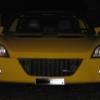
Hitec Vs Regal
#1

Posted 04 April 2005 - 09:36 AM
#2

Posted 04 April 2005 - 11:51 AM
#3

Posted 04 April 2005 - 12:17 PM
you have to remember that you do get variations especially the boost between supercharger and turbo charger configurations...
How does that work then?
I guess there is mecahnical power loss from a belt driven supercharger leading to slightly less power, but i wouldn't have expected it to be that much.
Cheers, Paul.
#4

Posted 04 April 2005 - 03:51 PM
This has something to do with the engine life. HITEC is not using the standard compression ratio, but has lowered it to somewhere around 8.5 from 10.5 If the turbo conversion keeps the original compression ratio, they will not able to go to higher boosts and even at 0.4 I would expect, that they will get a lot of issues with knocking and pinging. With the standard engine 2.2 liter you get approx. 15BHP / 0.1bar. You lose 15BHP as a result of the changed compression ratio, gets you down to 130BHP plus 7.5 times 15 BHP gets you to somewhere around the claimed 250BHP. Would you get 280BHP with a boost of 1.0 bar? YES.you have to remember that you do get variations especially the boost between supercharger and turbo charger configurations...
How does that work then?
I guess there is mecahnical power loss from a belt driven supercharger leading to slightly less power, but i wouldn't have expected it to be that much.
Cheers, Paul.
The chipped turbos VXT run at boost levels of 1.4 bar. You can consider yourself, what that means for the stress of the car. If HITEC would go to 1.4 bar, they would have 320BHP and -yes- would need better pistons and rods.
#2177
#5

Posted 04 April 2005 - 04:50 PM
This has something to do with the engine life. HITEC is not using the standard compression ratio, but has lowered it to somewhere around 8.5 from 10.5 If the turbo conversion keeps the original compression ratio, they will not able to go to higher boosts and even at 0.4 I would expect, that they will get a lot of issues with knocking and pinging. With the standard engine 2.2 liter you get approx. 15BHP / 0.1bar. You lose 15BHP as a result of the changed compression ratio, gets you down to 130BHP plus 7.5 times 15 BHP gets you to somewhere around the claimed 250BHP.
Interesting!
So, theoretically, if we had two systems - one with lowered compression and one without both producing the same bhp on different boost pressures, do they both cause the same amount of engine wear?
e.g. system 1: original compression ratio, boost 0.3- bhp 240
system 2: lowered compression ratio, boost 0.75- bhp 240
Do they both wear the engine the same?
Cheers, Paul.
#6

Posted 04 April 2005 - 06:01 PM
is is all about how much fuel can you get into the system without getting into pinging. With 0.4bar and standard compression, you can get to 210BHP with a high risk of pinging, which would damage the engine. To avoid this, you would have to use higher octane fuel and totally change the standard ecu ingnition timing. This package, if done well, could work without damaging the engine, but it would definetly be at the limits.This has something to do with the engine life. HITEC is not using the standard compression ratio, but has lowered it to somewhere around 8.5 from 10.5 If the turbo conversion keeps the original compression ratio, they will not able to go to higher boosts and even at 0.4 I would expect, that they will get a lot of issues with knocking and pinging. With the standard engine 2.2 liter you get approx. 15BHP / 0.1bar. You lose 15BHP as a result of the changed compression ratio, gets you down to 130BHP plus 7.5 times 15 BHP gets you to somewhere around the claimed 250BHP.
Interesting!
So, theoretically, if we had two systems - one with lowered compression and one without both producing the same bhp on different boost pressures, do they both cause the same amount of engine wear?
e.g. system 1: original compression ratio, boost 0.3- bhp 240
system 2: lowered compression ratio, boost 0.75- bhp 240
Do they both wear the engine the same?
Cheers, Paul.
The SC version could theoretically go up to 320BHP before pinging would damage the engine. It would then be more a conrods/piston issue.
#2177
#7

Posted 04 April 2005 - 06:53 PM
is is all about how much fuel can you get into the system without getting into pinging. With 0.4bar and standard compression, you can get to 210BHP with a high risk of pinging, which would damage the engine. To avoid this, you would have to use higher octane fuel and totally change the standard ecu ingnition timing. This package, if done well, could work without damaging the engine, but it would definetly be at the limits.
The SC version could theoretically go up to 320BHP before pinging would damage the engine. It would then be more a conrods/piston issue.
Ahhh, i see!
So, we have to wait and see what Regal have to say about this!
On the hitec SC how would you increase the boost - can you only do it through changing the belt?
Ps. thanks for answering all these questions!
Cheers, Paul.
#8

Posted 05 April 2005 - 05:45 AM
If the regal conversion uses the standard engine as they claim, they keep the standard compression ratio 10.5, HITEC has changed the compression ratio by increasing the space above the piston by a few mm. It is now around 8.5. To increase the boost in a SC application you will have to put a smaller pulley on the SC. It will then rev higher and create a higher pressure.is is all about how much fuel can you get into the system without getting into pinging. With 0.4bar and standard compression, you can get to 210BHP with a high risk of pinging, which would damage the engine. To avoid this, you would have to use higher octane fuel and totally change the standard ecu ingnition timing. This package, if done well, could work without damaging the engine, but it would definetly be at the limits.
The SC version could theoretically go up to 320BHP before pinging would damage the engine. It would then be more a conrods/piston issue.
Ahhh, i see!I guess if i keep asking questions the answers are going to get increasing more complex!
So as we increase the power, the compression ratio goes up and causes pinking?
So, we have to wait and see what Regal have to say about this!
On the hitec SC how would you increase the boost - can you only do it through changing the belt?
Ps. thanks for answering all these questions!
Cheers, Paul.
#2177
#9

Posted 05 April 2005 - 08:53 AM
To increase the boost in a SC application you will have to put a smaller pulley on the SC. It will then rev higher and create a higher pressure.
How much scope is there for putting smaller and smaller pullys on the SC - is it actually possible to find a pully to achieve >1.0 boost pressures? Do you have to start worrying about the pully itself breaking?
Cheers, Paul.
#10

Posted 05 April 2005 - 09:56 AM
I think 1 bar is the limit, otherwise you are revving the SC higher than specs allow!To increase the boost in a SC application you will have to put a smaller pulley on the SC. It will then rev higher and create a higher pressure.
How much scope is there for putting smaller and smaller pullys on the SC - is it actually possible to find a pully to achieve >1.0 boost pressures? Do you have to start worrying about the pully itself breaking?
Cheers, Paul.
the pulley is no problem.
#2177
#11

Posted 05 April 2005 - 10:54 AM
I think 1 bar is the limit, otherwise you are revving the SC higher than specs allow!
the pulley is no problem.
Cool
Will you run into pinking problems with >0.75 boost or is it just pistons/rods to worry about?
Cheers, Paul.
#12

Posted 05 April 2005 - 01:34 PM
just piston and rodsI think 1 bar is the limit, otherwise you are revving the SC higher than specs allow!
the pulley is no problem.
Cool.
Will you run into pinking problems with >0.75 boost or is it just pistons/rods to worry about?
Cheers, Paul.
#13

Posted 05 April 2005 - 01:39 PM
#14

Posted 05 April 2005 - 01:58 PM
just piston and rods
Heh heh....
Mind you, probably going to run into drive shaft/clutch problems at the level of
Cheers, Paul.
#15

Posted 05 April 2005 - 02:11 PM
Just as an idea of how much power a supercharger uses - on the Jag v8, the supercharger uses 70bhp - so although there is 400bhp at the flywheel the engine is producing 470bhp.
Would the high level of parasitic power loss here be due to the v8 needing more air than a four cylinder engine, or is that a common ratio?
Cheers, Paul.
#16

Posted 06 April 2005 - 10:10 AM
Edited by Jon, 06 April 2005 - 10:11 AM.
#17

Posted 06 April 2005 - 10:51 AM
Hi, Alex is quite right the supercharger will go to about 1 bar boost, however boost is not the next issue to look at. Above 245-250 bhp we have found that the standard OE exhaust manifold is struggling due to a build up of back pressure, so I am looking into having a better exhaust manifold made.
Ahhh, Alfred's exhaust elbow union! Of course
Exxxxxcellent.
Looking at the SAE report on the development of the 1000 bhp drag racing LM850 engine, it states that the rods are capable of a sustained 190KW (259.08 bhp) without failure, so we are well inside on the stage 2 conversion at 245 bhp.
Ah yes - for anyone whos not seen that report < here >, it really is quite interesting!
When the manifold is done and fitted and the power increase established it may well then be the time to look at the rods. This will then form the starting point for the stage 3 level
Its good to know there will be more stages in the future!!
Cheers, Paul.
1 user(s) are reading this topic
0 members, 1 guests, 0 anonymous users















